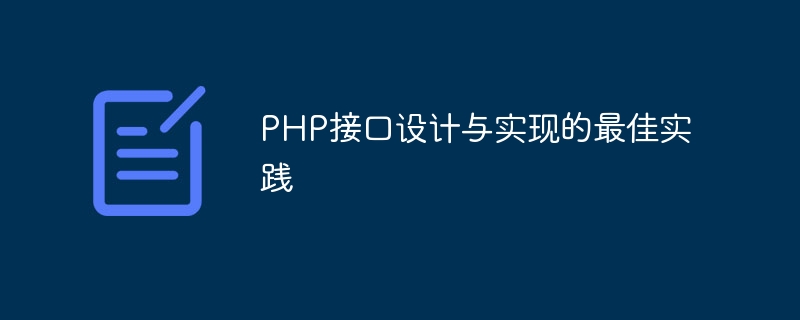Home >Backend Development >PHP Tutorial >Best practices for PHP interface design and implementation
Best practices for PHP interface design and implementation
- 王林Original
- 2024-03-25 08:39:031318browse

Best Practices in PHP Interface Design and Implementation
With the rapid development of the Internet, the design and implementation of Web interfaces have become more and more important. As a commonly used Web development language, PHP also plays an important role in interface design and implementation. This article will introduce the best practices for PHP interface design and implementation, and illustrate it through specific code examples.
1. Interface design principles
When designing a PHP interface, you need to follow some design principles to ensure the reliability, flexibility and scalability of the interface. The following are some commonly used interface design principles:
- Single Responsibility Principle (SRP): An interface should have only one responsibility, and do not put multiple unrelated functions in one interface.
- Open-Closed Principle (OCP): The interface should be open, but closed to modification. In other words, the interface should allow new functions to be extended without modifying the original code.
- Dependency Inversion Principle (DIP): Interfaces should rely on abstractions rather than specific implementations to reduce the coupling between modules.
- Interface Isolation Principle (ISP): Interfaces should be small and specialized, avoiding large and comprehensive interface designs. A class should only relate to the interfaces it needs.
- Law of Demeter (LoD): Also known as the principle of least knowledge, an object should know as little as possible about other objects.
The above principles can help us design a PHP interface with high cohesion and low coupling.
2. Interface Implementation Example
Next, we use a specific example to illustrate how to design and implement an interface in PHP. Suppose we need to implement a simple user management system, including the function of adding, deleting, modifying and checking users. Here we define a UserService interface and implement a UserService class based on the MySQL database to complete user operations.
<?php
// 定义UserService接口
interface UserService {
public function createUser($userData);
public function getUserById($userId);
public function updateUser($userId, $newUserData);
public function deleteUser($userId);
}
// 实现UserService接口
class MySQLUserService implements UserService {
private $db;
public function __construct($db) {
$this->db = $db;
}
public function createUser($userData) {
// 实现创建用户的逻辑
}
public function getUserById($userId) {
// 实现根据用户ID获取用户信息的逻辑
}
public function updateUser($userId, $newUserData) {
// 实现更新用户信息的逻辑
}
public function deleteUser($userId) {
// 实现删除用户的逻辑
}
}
// 使用示例
$db = new PDO('mysql:host=localhost;dbname=test', 'username', 'password');
$userService = new MySQLUserService($db);
$userData = ['username' => 'Alice', 'email' => 'alice@example.com'];
$userService->createUser($userData);
$user = $userService->getUserById(1);
var_dump($user);The above code example demonstrates how to design a UserService interface and implement a UserService class based on the MySQL database. By following the interface design principles, we can implement a highly cohesive and low-coupling PHP interface, making our code more maintainable and scalable.
Summary
PHP interface design and implementation is a crucial part of Web development. A good interface design can make our code more flexible, reliable and easy to expand. When designing a PHP interface, we should follow the interface design principles and implement our interface through specific code examples. I hope this article is helpful to you, welcome to share and communicate!
The above is the detailed content of Best practices for PHP interface design and implementation. For more information, please follow other related articles on the PHP Chinese website!
Related articles
See more- Java custom annotation interface implementation solution
- Best practices for SSL/TLS security configuration of Nginx
- How to connect to Alibaba Cloud face detection interface through PHP to implement face recognition function
- Building secure web interfaces: Best practices for Linux servers.
- Linux server protection guide: Securing your web interface.

